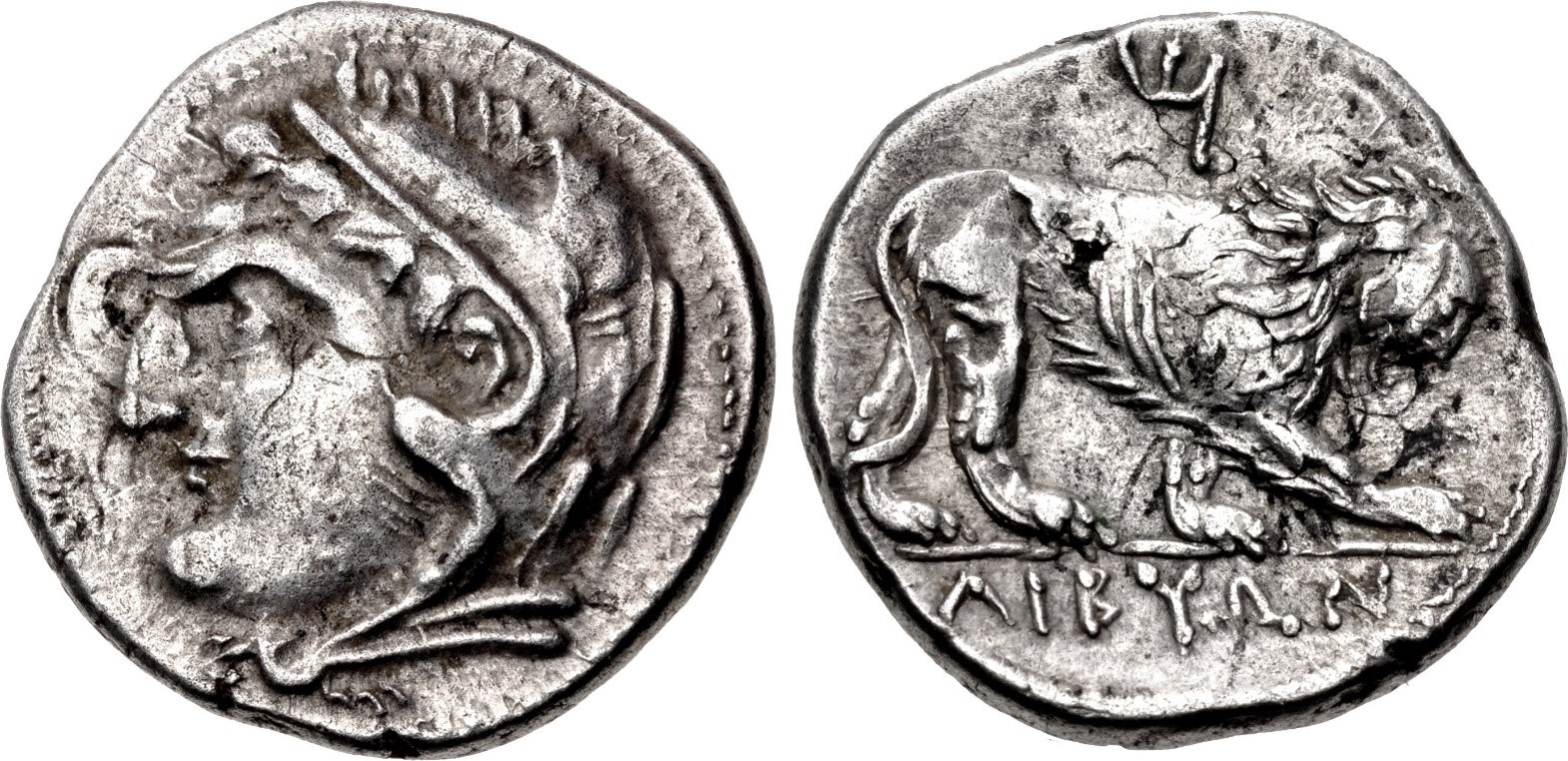3283 - Zeugitana (uncertain mint) (Lybian revolt) (shekel Heracles/lion) over Carthago Nova (Hanibal?/horse and palm tree) (CNG, 108, May 2018, 24): Difference between revisions
From SILVER
No edit summary |
No edit summary |
||
| Line 25: | Line 25: | ||
|Overstruck obverse description=Male head l. (Hannibal?). | |Overstruck obverse description=Male head l. (Hannibal?). | ||
|Overstruck reverse description=Horse standing r.; behind, palm tree | |Overstruck reverse description=Horse standing r.; behind, palm tree | ||
|Overstruck mint=Carthago Nova | |||
|Overstruck ancient region=Hispania Ulterior | |||
|Overstruck authority=Carthaginian Empire | |Overstruck authority=Carthaginian Empire | ||
|Overstruck date from=237 BCE | |Overstruck date from=237 BCE | ||
Revision as of 13:48, 25 April 2024
241 BCE - 238 BCE | ΛΙΒΥΩΝ
Location/history
| Sale(s)Sale(s) ᵖ: | Bruun-Rasmussen, 874, 7 Nov. 2017, 21 = Classical Numismatic Group, 108, 16 May 2018, 24 | |
Overstriking coin
Description
| ObverseInscription or printing placed on the obverse.: | Head of Herakles left, wearing lion skin headdress. Border of dots. | ReverseInscription or printing placed on the reverse.: | ΛΙΒΥΩΝ (Greek) Lion prowling right. Above, 'M' (Punic letter). Border of dots. |
Mint and issuing power
| MintIdentifies the place of manufacture or issue of a numismatic object.: | Zeugitana (uncertain mint) | Ancient regionAncient region. | Zeugitana | Modern countryModern country: Tunisia | AuthorityIdentifies the issuing power. The authority can be "pretended" when the name or the portrait of X is on the coin but he/she was not the issuing power. It can also be "uncertain" when there is no mention of X on the coin but he/she was the issuing power according to the historical sources: | Carthaginian Empire |
Chronology
| FromIdentifies the initial date in a range assigned in a numismatic context. 241 BCE toIdentifies the final date in a range assigned in a numismatic context.. 238 BCE | Hellenistic 323-30 BC |
Physical description
| MetalThe physical material (usually metal) from which an object is made.: Silver |
WeightWeight of the numismatic object (in grams). in grams: 7.327.32 g <br />7,320 mg <br /> | DenominationTerm indicating the value of a numismatic object. Examples: tetradrachm, chalkous, denarius.: shekel |
AxisDescribes the directional relationship between the obverse and reverse of a numismatic object.: 1111 mm <br />1.1 cm <br /> |
| DiameterDescribes diameter of an object (in mm).: 2323 mm <br />2.3 cm <br /> | StandardStandard.: Punic | ||
References
| Coin referenceReference of the Coin: | Coin series referenceReference to coin series study: | Alexandropoulos 20071Alexandropoulos 2007, n° 53 | |
| Coin series web referenceCoin series web references: | |||
Overstruck type
Description
| ObverseInscription or printing placed on the obverse.: | Male head l. (Hannibal?). | ReverseInscription or printing placed on the reverse.: | Horse standing r., behind, palm tree |
Mint and issuing power
| MintIdentifies the place of manufacture or issue of a numismatic object. ᵖ: | Carthago Nova | Ancient regionAncient region. ᵖ | Hispania Ulterior | Modern countryModern country: Spain | AuthorityIdentifies the authority in whose name (explicitly or implicitly) a numismatic object was issued. ᵖ: | Carthaginian Empire |
Chronology
| FromIdentifies the initial date in a range assigned in a numismatic context. 237 BCE toIdentifies the final date in a range assigned in a numismatic context.. 209 BCE | Hellenistic 323-30 BC |
Physical description
| DenominationTerm indicating the value of a numismatic object. Examples: tetradrachm, chalkous, denarius. ᵖ: | shekel |
References
| Coin type referenceReference to coin series study ᵖ: |
Additional data
| Frequency of overstrikesFrequency of overstrikes: | frequent | Level of confidenceLevel of confidence of the identification: | |
| RemarksRemarks: | "There are traces of the undertype visible, but none are distinct enough to suggest a particular issue, save for what appears to be the tail of a dolphin or hippocamp near the edge on the obverse, at the forehead of Herakles. The undertype must be of a similar weight standard. The only issue that seems to fit is the Ibero-Punic shekel with a male head on the obverse and a reverse featuring a prow facing right, below which a dolphin swims right (ACIP 543)." | ||
References
- ^ Alexandropoulos, Jacques (2007), Les monnaies de l'Afrique antique (400 av. J.-C.-40 ap. J.-C.), Presses universitaires du Mirail, Toulouse, 507 p., 17 pl.

